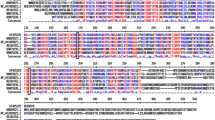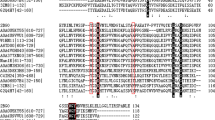Abstract
The structure of a novel psychrophilic β-mannanase enzyme from Glaciozyma antarctica PI12 yeast has been modelled and analysed in detail. To our knowledge, this is the first attempt to model a psychrophilic β-mannanase from yeast. To this end, a 3D structure of the enzyme was first predicted using a threading method because of the low sequence identity (<30 %) using MODELLER9v12 and simulated using GROMACS at varying low temperatures for structure refinement. Comparisons with mesophilic and thermophilic mannanases revealed that the psychrophilic mannanase contains longer loops and shorter helices, increases in the number of aromatic and hydrophobic residues, reductions in the number of hydrogen bonds and salt bridges and numerous amino acid substitutions on the surface that increased the flexibility and its efficiency for catalytic reactions at low temperatures.







Similar content being viewed by others
References
Kokkinidis M, Glykos NM, Fadouloglou VE (2012) Protein flexibility and enzymatic catalysis. Adv Protein Chem Struct Biol 87:181–218
Metpally RPR, Reddy BVB (2009) Comparative proteome analysis of psychrophilic versus mesophilic bacterial species: insights into the molecular basis of cold adaptation of proteins. BMC Genomics 10:11
Liu Z, Qi W, He Z (2008) Optimization of beta-mannanase production from Bacillus licheniformis TJ-101 using response surface methodology. Chem Biochem Eng Q 22:355–362
Wang M, You S, Zhang S, Qi W, Liu Z, Wu W, Su R, He Z (2013) Purification, characterization, and production of β-mannanase from Bacillus subtilis TJ-102 and its application in gluco-mannooligosaccharides preparation. Eur Food Res Technol 237:399–408
Haiqiang L, Huitu Z, Pengjun S, Huiying L (2013) A family 5 β-mannanase from the thermophilic fungus Thielavia arenaria XZ7 with typical thermophilic enzyme features. Appl Microb Biotechnol 97:8121–8128
Chantorn ST, Buengsrisawat K, Pokaseam A, Sombat T, Dangpram P, Jantawon K, Nitisinprasert S (2013) Optimization of extracellular mannanase production from Penicillium oxalicum KUB-SN2-1 and application for hydrolysis property. J Sci Technol 35(1):17–22
Ourgault R, Bewley JD (2002) Variation in its C-terminal amino acids determines whether endo-beta-mannanase is active or inactive in ripening tomato fruits of different cultivars. Plant Physiol 130(3):1254–1262
Xu B et al (2002) Endo-β-1,4-Mannanases from blue mussel, Mytilus edulis: purification, characterization, and mode of action. J Biotechnol 92(3):267–277
Davies G, Henrissat B (1995) Structures and mechanisms of glycosyl hydrolases. Structure 3:853–859
El-Naggar MY et al (2006) Extracellular β-Mannanase production by the immobilization of the locally isolated Aspergillus niger. Int J Agric Biol 8(1):57–62
Ehsani M, Torki M (2010) Effects of dietary inclusion of guar meal supplemented by β-Mannanase on performance of laying hens. Egg Qual Charact Diacritical Count White Blood Cells 5(4):237–243
Zhou H, Yang Y, Nie X, Yang W, Wu Y (2013) Comparison of expression systems for the extracellular production of mannanase Man23 originated from Bacillus subtilis B23. Microb Cell Fact 12:78
Lee JT, Bailey CA, Cartwright AL (2003) Beta-Mannanase ameliorates viscosity-associated depression of growth in broiler chickens fed guar germ and hull fractions. Poult Sci 82(12):1925–1931
Chandra M et al (2011) Isolation, purification and characterization of a thermostable β-Mannanase from Paenibacillus sp. DZ3. J Korean Soc Appl Biol Chem 54(3):325–331
Tailford LE, Ducros VM-A, Flint JE, Roberts SM, Morland C, Zechel DL, Smith N, Bjørnvad ME, Borchert TV, Wilson KS, Davies GJ, Gilbert HJ (2009) Understanding how diverse beta-mannanases recognize heterogeneous substrates. Biochemistry 48:7009–7018
Park SH, Park KH, Oh BC, Alli I, Lee BH (2011) Expression and characterization of an extremely thermostable B-glycosidase (mannosidase) from the hyperthermophillic archaeon Pyrococcus furiosus DSM 3638. N Biotechnol 28:639–648
Goncalves AM, Silva C, Madeira T, Coelho R, Sanctis D, Romao MV, Bento I (2012) Endo-β-D-1,4-mannanase from Chrysonilia sitophila displays a novel loop arrangement for substrate selectivity. Acta Cryst D68:1468–1478
Zhao Y, Zhang Y, Cao Y, Qi J, Mao L, Xue Y, Gao F, Peng H, Wang X, Gao G, Ma Y (2011) Structural analysis of alkaline β-Mannanase from alkaliphilic Bacillus sp. N16-5: implications for adaptation to alkaline conditions. PLoS ONE 6(1):e14608
Santos CR, Squina FM, Navarro AM, Ruller R, Prade R, Murakami MT (2010) Cloning, expression, purification, crystallization and preliminary X-ray diffraction studies of the catalytic domain of a hyperthermostable endo-1,4-β-D-mannanase from Thermotoga petrophila RKU-1. Acta Cryst F66:1078–1081
Akita M, Takeda N, Hirasawa K, Sakai H, Kawamoto M, Yamamoto M, Grant WD, Hatada Y, Ito S, Horikoshi K (2004) Crystallization and preliminary X-ray study of alkaline mannanase from an alkaliphilic Bacillus isolate. Acta Cryst D60:1490–1492
Sabini E, Schubert H, Murshudov G, Wilson KS, Siika-Aho M, Penttila M (2000) The three-dimensional structure of a Trichoderma reesei beta-mannanase from glycoside hydrolase family 5. Acta Cryst D56:3–13
Larsson AM, Anderson L, Xu B, Munoz IG, Uson I, Janson JC, Stalbrand H, Stahlberg J (2006) Three-dimensional crystal structure and enzymic characterization of β-mannanase Man5A from blue mussel Mytilus edulis. J Mol Biol 357:1500–1510
Bourgault R et al (2005) Three-dimensional structure of (1,4)-β-D-mannan mannanohydrolase from tomato fruit. Protein Sci 14:1233–1241
Zakaria MM, Yamamoto S, Yagi T (1998) Purification and characterization of an endo-1,4-β-mannanase from Bacillus subtilis KU-1. FEMS Microbiol Lett 158:25–31
Huang JW, Chen CC, Huang CH, Huang TY, Wu TH, Cheng YS, Ko TP, Lin CY, Liu JR, Guo RT (2014) Improving the specific activity of β-mannanase from Aspergillus niger BK01 by structure-based rational design. Biochimica et Biophysica Acta (BBA) Proteins and Proteomics 1844(3):663–669
Ramli ANM et al (2011) Molecular cloning, expression and biochemical characterisation of a cold-adapted novel recombinant chitinase from Glaciozyma antarctica PI12. Microb Cell Fact 10(1):94
Altschul SF et al (1997) Gapped BLAST and PSI-BLAST: a new generation of protein database search programs. Nucleic Acid Res 25(17):3389–3402
Altschul SF et al (1990) Basic local alignment search tool. J Mol Biol 215(3):403–410
Gough J et al (2001) Assignment of homology to genome sequences using a library of hidden Markov models that represent all proteins of known structure. J Mol Biol 313(4):903–919
Fornes O et al (2009) ModLink+: improving fold recognition by using protein–protein interactions. Bioinformatics 25(12):1506–1512
Söding J, Biegert A, Lupas AN (2005) The HHpred interactive server for protein homology detection and structure prediction. Nucleic Acid Res 33(2):W244–W248
Jones DT (1999) An efficient and reliable protein fold recognition method for genomic sequences. J Mol Biol 287(4):797–815
Kelley LA, Sternberg MJE (2009) Protein structure prediction on the web: a case study using the Phyre server. Nat Protoc 4(3):363–371
Eswar N et al (2007) Comparative protein structure modeling using MODELLER. Curr Protoc Bioinformatics 2(1):1–30
Zhang Y, Skolnick J (2005) TM-align: a protein structure alignment algorithm based on the TM-score. Nucleic Acid Res 33(7):2302–2309
Luthy R, Bowie JU, Eisenberg D (1992) Assessment of protein models with three-dimensional profiles. Nature 356(6364):83–85
Laskowski RA et al (1993) PROCHECK: a program to check the stereochemical quality of protein structures. J Appl Crystallogr 26(2):283–291
Colovos C, Yeates TO (1993) Verification of protein structures: patterns of nonbonded atomic interactions. Protein Sci 2(9):1511–1519
Wiederstein M, Sippl MJ (2007) ProSA-web: interactive web service for the recognition of errors in three-dimensional structures of proteins. Nucleic Acid Res 35(2):W407–W410
Hess B et al (2008) GROMACS 4: algorithms for highly efficient, load-balanced, and scalable molecular simulation. J Chem Theory Comput 4(3):435–447
Couturier M, Roussel A, Rosengren A, Leone P, Stalbrand H, Berrin JG (2013) Structural and biochemical analyses of glycoside hydrolase families 5 and 26 β-(1,4)-mannanases from Podospora anserina reveal differences upon manno-oligosaccharide catalysis. J Biol Chem 288:14624
Costantini S, Colonna G, Facchiano AM (2008) ESBRI: a web server for evaluating salt bridges in proteins. Bioinformation 3(1):137–138
Pettersen E et al (2004) UCSF Chimera–a visualization system for exploratory research and analysis. J Comput Chem 25(13):1605–1612
Chaitanya M et al (2010) Exploring the molecular basis for selective binding of Mycobacterium tuberculosis Asp kinase toward its natural substrates and feedback inhibitors: a docking and molecular dynamics study. J Mol Model 16(8):1357–1367
Geralt M, Alimenti C, Vallesi A, Luporini P, Wuthrich K (2013) Thermodynamic stability of psychrophilic and mesophilic pheromones of the protozoan ciliate euplotes. Biology 2:142–150
Alvarez M et al (1998) Triose phosphate isomerase (TIM) of the psychrophilic Bacterium Vibrio marinus. J Biol Chem 273:2199–2206
Wallon G et al (1997) Sequence and homology model of 3-isopropylmalate dehydrogenase from the psychrotrophic bacterium Vibrio sp. I5 suggest reasons for thermal instability. Protein Eng 10(6):665–672
Davail S et al (1994) Cold adaptation of proteins. Purification, characterization, and sequence of the heatlabile subtilisin from the antarctic psychrophile Bacillus TA41. J Biol Chem 269(26):17448–17453
Herning T et al (1992) Role of proline residues in human lysozyme stability: a scanning calorimetric study combined with X-ray structure analysis of proline mutants. Biochemistry 31(31):7077–7085
Kumar S, Nussinov R (2004) Different roles of electrostatics in heat and in cold: adaptation by citrate synthase. Chem Biochem 5(3):280–290
Alimenti C et al (2009) Molecular cold-adaptation: comparative analysis of two homologous families of psychrophilic and mesophilic signal proteins of the protozoan ciliate, Euplotes. IUBMB Life 61(8):838–845
Galkin A et al (1999) Coldadapted alanine dehydrogenases from two Antarctic bacterial strains: gene cloning, protein characterization, and comparison with mesophilic and thermophilic counterparts. Appl Environ Microbiol 65(9):4014–4020
Kim SY et al (1999) Structural basis for cold adaptation. J Biol Chem 274(17):11761–11767
Zuber H (1988) Temperature adaptation of lactate dehydrogenase Structural, functional and genetic aspects. Biophys Chem 29(1–2):171–179
Saunders N et al (2003) Mechanisms of thermal adaptation revealed from the genomes of the antarctic archaea Methanogenium frigidum and Methanococcoides burtonii. Genome Res 13(7):1241–1255
Kundu S, Roy D (2009) Comparative structural studies of psychrophilic and mesophilic protein homologues by molecular dynamics simulation. J Mol Graph Model 27(8):871–880
Kumar S, Nussinov R (1999) Salt bridge stability in monomeric proteins. J Mol Biol 293(5):1241–1255
Ramli ANM, Mahadi NM, Shamsir MH (2012) Structural prediction of a novel chitinase from the psychrophilic G. antarctica PI12 and an analysis of its structural properties and function. J Comput Aided Mol Des 26:947–961
Bae E, Phillips G (2004) Structures and analysis of highly homologous psychrophilic, mesophilic, and thermophilic adenylate kinases. 279(27):28202–28208
Tronelli D et al (2007) Structural adaptation to low temperatures—analysis of the subunit interface of oligomeric psychrophilic enzymes. FEBS J 274(17):4595–4608
Author information
Authors and Affiliations
Corresponding author
Rights and permissions
About this article
Cite this article
Parvizpour, S., Razmara, J., Ramli, A.N.M. et al. Structural and functional analysis of a novel psychrophilic β-mannanase from Glaciozyma antarctica PI12. J Comput Aided Mol Des 28, 685–698 (2014). https://doi.org/10.1007/s10822-014-9751-1
Received:
Accepted:
Published:
Issue Date:
DOI: https://doi.org/10.1007/s10822-014-9751-1




